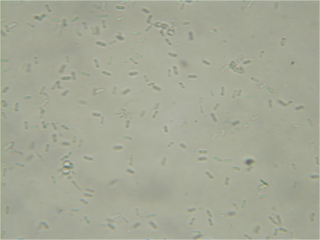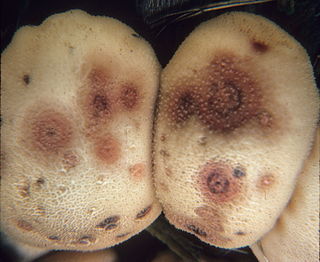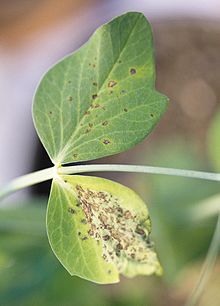
Pier Andrea Saccardo was an Italian botanist and mycologist. He was also the author of a color classification system that he called Chromotaxia. He was elected to the Linnean Society in 1916 as a foreign member. His multi-volume Sylloge Fungorum was one of the first attempts to produce a comprehensive treatise on the fungi which made use of the spore-bearing structures for classification.

The Pleosporales is the largest order in the fungal class Dothideomycetes. By a 2008 estimate, it contained 23 families, 332 genera and more than 4700 species. The majority of species are saprobes on decaying plant material in fresh water, marine, or terrestrial environments, but several species are also associated with living plants as parasites, epiphytes or endophytes. The best studied species cause plant diseases on important agricultural crops e.g. Cochliobolus heterostrophus, causing southern corn leaf blight on maize, Phaeosphaeria nodorum causing glume blotch on wheat and Leptosphaeria maculans causing a stem canker on cabbage crops (Brassica). Some species of Pleosporales occur on animal dung and a small number occur as lichens and rock-inhabiting fungi.

Phoma is a genus of common coelomycetous soil fungi. It contains many plant pathogenic species.
Mycotodea is a genus of fungi in the Ascomycota division. It was later placed in the Leptosphaeriaceae family. The widespread genus contained 14 species, before most were transferred to Leptosphaerulina and Leptopeltis genera. It was left as a monotypic genus, with just Mycotodea litoreaKirschst. (1939).

Descolea is a genus of fungi in the family Bolbitiaceae. Described by mycologist Rolf Singer in 1952, the widespread genus contains about 15 species. It was formerly placed in the family Cortinariaceae because of its limoniform basidiospores and its ectomycorrhizal lifestyle. A 2013 molecular phylogenetics study by Tóth et al. found it to be closely related to the genus Pholiotina The genus Pseudodescolea, erected for the single Descolea-like species Pseudodescolea lepiotiformis, was formerly considered distinct until a 1990 study found it to be a synonym of Descolea antarctica.
The Vialaeaceae are a family of fungi in the Ascomycota and class Sordariomycetes. In 2018, it was placed in the order Amphisphaeriales.
Rebentischia is a genus in the Tubeufiaceae family of fungi.

Holwaya is a genus of fungi in the family Bulgariaceae. Holwaya is monotypic, containing the single species Holwaya mucida, which was originally named Bulgaria ophiobolus by Job Bicknell Ellis in 1883, and later transferred to the newly created Holwaya by Pier Andrea Saccardo in 1889. The genus name of Holwaya is in honour of Edward Willet Dorland Holway (1853-1923), who was an American botanist (Mycology) and Banker.
Calophoma clematidina is a fungal plant pathogen and the most common cause of the disease clematis wilt affecting large-flowered varieties of Clematis. Symptoms of infection include leaf spotting, wilting of leaves, stems or the whole plant and internal blackening of the stem, often at soil level. Infected plants growing in containers may also develop root rot.
Stagonosporopsis is a genus of ascomycote fungi, containing several pathogens to plants.
Hubertus Antonius van der Aa was a Dutch mycologist who described several genera and species of fungi. He studied at Utrecht University where he received his PhD in 1973 with the dissertation Studies in phyllosticta I.

The Didymellaceae are a family of fungi in the order Pleosporales. The have a world-wide distribution.
Peyronellaea curtisii is a fungal plant pathogen first described by Miles Joseph Berkeley and received its current name in 2010. Formerly it was Stagonosporacurtisii. It is a cause of leaf blotch, and its substrates include Narcissus, Galanthus and Hippeastrum.
Phoma wilt is a disease of the common hop plant caused by several species of fungal plant pathogens in the genus Phoma. These include Phoma herbarum and Phoma exigua, and possibly other as yet unidentified species. Phoma infection may cause decreased yields, but Phoma wilt is not considered to be a very common or destructive disease of the hop plant.
Aposphaeria is a genus of fungi in the family Melanommataceae. The genus was circumscribed in 1880 by Pier Andrea Saccardo, with Aposphaeria pulviscula selected as the type species.
Boeremia is a genus of fungi belonging to the family Didymellaceae. It was first described by M.M. Aveskamp, J. de Gruyter, J.H.C. Woudenberg, G.J.M. Verkley and P.W. Crous in 2010, and the type species is Boeremia exigua.

Boeremia exigua is the type species of the fungus genus, Boeremia, in the Didymellaceae family. It was first described as Phoma exigua by John Baptiste Henri Joseph Desmazières in 1849, and transferred to the genus, Boeremia, by M.M. Aveskamp, J. de Gruyter, J.H.C. Woudenberg, G.J.M. Verkley and P.W. Crous in 2010.

Epicoccum is a genus of fungi belonging to the family Didymellaceae.
The Lentitheciaceae are a family of fungi in the order of Pleosporales. They are found world-wide with the greatest contributions found in Europe and Australia.







